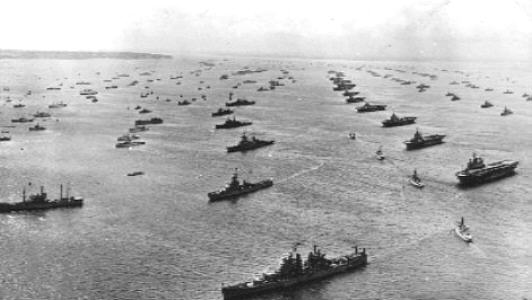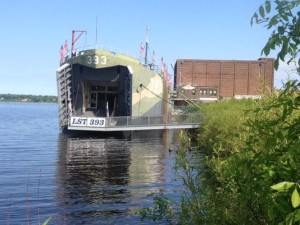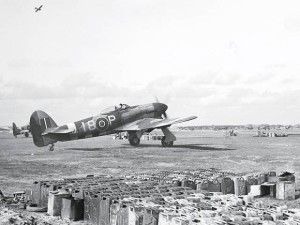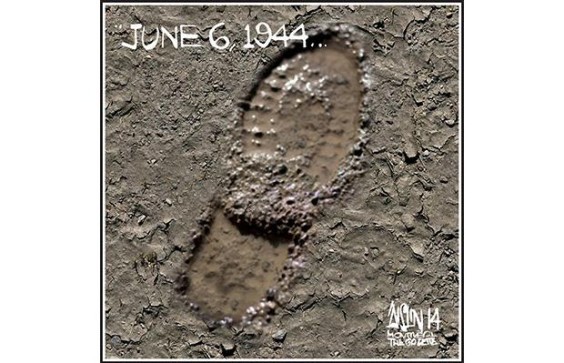Re The UN General Assembly Speaker Schedule is Here! I note that whoever will be speaking for Canada this year…
D-Day + 70
Written by Diana Thebaud Nicholson // June 8, 2014 // Europe & EU // Comments Off on D-Day + 70
See also Days in history on Wednesday-Night.com
CBC Is Tweeting A Blow-By-Blow Account Of D-Day, And It’s Incredible
(Business Insider) The Canadian Broadcasting Corporation (CBC) is tweeting a fascinating blow-by-blow account of the D-Day invasion that took place 70 years ago tomorrow.
The D-Day invasion, code named Operation Overlord, was the largest seaborne invasion in history. Almost 5,000 landing and assault craft, accompanied by 289 escort vessels and 277 minesweepers, from Canada, the U.S., Britain, and Australia took part in the operation. The Allies suffered a total of 226,386 casualties, but it proved a decisive moment in the war.
The successful landing of Allied forces at Normandy opened up a second front which split Nazi forces throughout Europe. This allowed the Soviets to more quickly march on Berlin, hastening the end of the war.
To honor D-Day, CBC is “live-tweeting” the war with an emphasis on Canadian contributions to the operation. Visit the official CBC Twitter feed to see the entire stream.
(National Archives/Media Matters) Images of the Week (D-Day in Color) highlighting color photographs taken as the Western Allies prepared for the invasion of Normandy (D-Day). The overwhelming majority of D-Day related color still film found in the National Archives document the pre-assault phase and not of the invasion area. Black-and-White photographs and other D-Day related documents from the National Archives can be found in our Online Public Access (OPA) system and in the new online exhibit “1944 – D-Day and The Normandy Invasion”.
D-Day Invasion: View From Above
(Wall Street Journal) June 6 is the 70th anniversary of the D-Day landings of World War II, which led to the liberation of France. Take a look at a series of aerial views of the Allied invasion of Nazi-occupied France on June 6, 1944.
CBS reports from Normandy on D-Day assault
June 6, 2014, 4:24 PM|From the archives: A CBS radio broadcast details the Allies’ attack on Normandy as it unfolds on June 6, 1944. (also: Complete Broadcast Day, D Day, June 06 1944
A rare look at WW2 in colour – ‘George Stevens: D-Day To Berlin’
(Euronews) When the British warship HMS Belfast fired the shot that launched the D-Day landings, it was carrying an unlikely passenger – Hollywood film director George Stevens. He was on board making a unique documentary for US Army archives.
His work at that time is the subject of the film ‘George Stevens: D-Day to Berlin’ made 50 years later.
It is an important historical document in several ways, not the least of which is the chance to see colour film from this era.
Termed the ‘Stevens Irregulars’, the film crew shot official footage on 35mm monochrome film, but Stevens also shot 14 cans of 16mm colour Kodachrome as he and the crew followed the Allied campaign across Europe.
After the war however, the images were forgotten until Stevens’ son, George Stevens Jr, discovered them after his father’s death, and was amazed. He then put the documentary together, narrated it and added excerpts from audio interviews with surviving veterans.
HuffPost: 20 Powerful D-Day Photos On The 70th Anniversary Of The Invasion
Wikipedia: Normandy landings
Untold Stories of D-Day
A grand hoax, top secret maps, and live-ammunition rehearsals set the stage for June 6, 1944, when 200,000 soldiers stormed Normandy’s beaches to help free Europe.
(Originally published in the June 2002 National Geographic)
June 6 dawns, and D-Day once more returns to Normandy. The tide is low at Utah Beach and Omaha Beach, as it was then. The sand hardens underfoot, as it did then. I touch a rusted metal stump thrusting from the sand, a remnant of the rows of barriers that lined this shore on June 6, 1944. Clouds crowd the sky this morning. It will be a gray day, as it was then.
To this shore every June come clusters of silent men who walk with their kin and their memories. One of them is Joseph Vaghi, a warm, vigorous Navy veteran who was a beachmaster on D-Day—“a kind of traffic cop,” he says—at a bloody stretch of Omaha Beach code-named Easy Red sector.
I met Vaghi on the wind-scoured bluffs overlooking those gray sands, now so empty and calm. Nearby was the American cemetery with its 9,387 graves, 23 of them carrying the names of men from Joe’s outfit, the Sixth Naval Beach Battalion. Its men disabled mines, marked sea-lanes for landing craft, cared for the beachhead wounded under fire, and bore them through a reddening sea to evacuation craft. The day I met him, Vaghi was helping to dedicate a belated memorial to his fallen comrades. So humble was their outfit, he laughed, that the United States armed forces—even the Navy—forgot about them for nearly 60 years.
It was to meet men like Joe Vaghi, and to hear their stories, that I came to Normandy last summer. I was searching for the untold saga of D-Day, those fascinating bits of history and heroism that have gone largely unreported in the decades since that terrible morning on the beach. (June 2002)
Hard truths of D-Day: A date at Normandy
Gwynne Dyer
Hitler never intended to conquer Britain and was surprised when his armed forces overran France in 1940. He was certainly not out to “conquer the world,” a preposterous ambition for a country of only 80 million people. His real target was Russia: the “Jewish-Bolshevik” Soviet Union. And he couldn’t even conquer that.
(Winnipeg Free Press) The presence of President Vladimir Putin on the Normandy beaches on the 70th anniversary of the D-Day landings was planned long before the current conflict over Ukraine, but it is a useful reminder of the fact that Russia is not some Asiatic tyranny on Europe’s eastern borders. It is a European country that has played a major role in the continent’s affairs for centuries.
Not only were the Russians on the same side as the western Allies in the Second World War, they did most of the heavy lifting in the war against Nazi Germany and they paid by far the highest price.
While 850,000 American, British and Canadian troops were landing on the French coast in June of 1944, six million soldiers of the Soviet army were fighting massive battles with the German army in eastern Europe. The land war on the Eastern Front was already three years old, and by June of 1944 the Russians had won: The Germans had already begun the long retreat that ended above Hitler’s bunker in Berlin 11 months later.
The price the Russians paid for their victory over Nazi Germany was huge: at least 11 million military dead (compared to fewer than one million dead for the Western allies). No other country in history has lost so many soldiers, but in the end it was the Red Army that destroyed Hitler’s Wehrmacht: 80 per cent of Germany’s six million military dead were killed on the Eastern Front.
The main strategic significance of the Normandy landings, therefore, was not the defeat of Germany, which was already assured. It was the fact Moscow had to accept Europe would be divided between the victors down the middle of Germany, rather than along some line further west that ran down the Franco-German border, or even down the English Channel.
President Putin, who began his career as a KGB agent working in Soviet-dominated East Germany, will certainly be aware of the irony he is commemorating a military operation whose main result was to contain Soviet power. And his presence will remind all the other participants the Second World War was not really fought to defend democracy from tyranny.
 D-Day facts: how the allied forces assembled the largest seaborne operation in history with video
D-Day facts: how the allied forces assembled the largest seaborne operation in history with video
(The Telegraph UK) The operation, which took 288 days of planning and lasted 85 days, involved 6,939 ships during the D-Day landings, which were manned by 195,700 naval personnel. Landing on the French coast were a total of 156,115 allied troops, including 73,000 from the US and 61,715 from Britain.
Alongside them marched 100,000 fictional soldiers of the First US Army Group – a fake force simulated by only 400 men with radios. The ghost army was part of another numbers game: the extensive deception of Operation Bodyguard, a collaboration between Bletchley Park mathematicians and the erratic double agents of the British spy system.
D-Day Historian Craig Symonds Talks About History’s Most Amazing Invasion
(The Daily Beast) Craig L. Symonds: … Of all the searing memories that participants recalled afterward, the one nearly everyone recalled was the carpet of shipping that crowded the mid-Channel rendezvous. Numbers are sterile, but depending on how you count, between five and six thousand Allied ships, embarking from 171 ports, took part in the invasion. By nightfall on June 6, the Allies had landed 132,450 American, British, and Canadian soldiers on French soil, along with thousands of tanks, jeeps, trucks and other vehicles. (see very good Wikipedia entry on LSTs)
Andrew Jackson Higgins and the Boats That Won World War II, by Jerry E. Strahan
(Publisher’s Weekly) Allied commander-in-chief Dwight Eisenhower called him “the man who won the war for us”–Andrew Higgins (1886-1952), who designed and mass-produced the landing craft that carried American troops ashore in the Pacific and European theaters of WW II. [The patent was registered on Feb 15, 1944 – less than four months before D-Day!) Strahan’s rousing story is about the New Orleans businessman who, while fighting the Navy bureaucracy to assure that U.S. forces had the finest amphibious craft possible, became head of one of the largest industrial complexes in the world.
New Orleans’ Andrew Higgins featured in PBS’ ‘D-Day’s Sunken Secrets’
A brief segment in the two-hour special documents the role of New Orleans’ Andrew Higgins and his LCVP craft in the war. Since the Higgins boats were made of wood, time and water have washed away all traces of them at Normandy. … Higgins’ line of amphibious crafts were used in both war theaters. The unique design of the LCVP, which moved infantry and vehicles from larger vessels to the shore, made it “a bridge to the beach” for troops in peril, Strahan said. One key design feature, as recognized in “D-Day’s Sunken Secrets” was the boat’s front gate, which allowed rapid exit under fire.
“The one thing the couple of guys have told me is that they consider the ramp ‘the gate to hell,'” Strahan said. “Once the ramp was down, you had no protection in front of you. You were just there.
“The boats were just meant to get people to the beach. They weren’t heavily armored. They didn’t have a gun. They did their job of transporting the men from the ships at sea to the beach.” More on the LCVP
Muskegon’s LST-393 landed on Omaha Beach on D-Day
At the start of World War II, Winston Churchill said to win the war he needed a ship capable of delivering tanks and troops to a defended shore. Two years later the first LSTs were being tested.
The unique ships were built to carry tanks, weapons, and troops from England to France. The ships’ massive front doors could open and allow tanks and other vehicles to drive onto beaches in France starting June 6, 1944.
More than 1,000 LSTs were built for the mission and there’s one still floating on Muskegon Lake.Only two LSTs are left in America, the other is in Indiana.
5 June
The Lancaster Bomber- D-Day’s Workhorse
(CBC) The planes of D-Day have taken on legendary status. And the most famous of all was the Lancaster. Today, only two in the world still fly. And one of them is at the Canadian Warplane Heritage Museum near Hamilton, Ontario. CBC The National’s Peter Mansbridge buckled in for a trip back in time and explores a personal connection [his father, Stanley was a Lancaster navigator] to the bomber plane that played a key role on D-Day.
4 June
 Roper and Knight: Coming to Canada — the Typhoon fighter-bomber that terrified the Nazis and helped win D-Day
Roper and Knight: Coming to Canada — the Typhoon fighter-bomber that terrified the Nazis and helped win D-Day
(National Post) On June 6, the 70th anniversary of D-Day, Canada will welcome the only remaining original and complete Hawker Typhoon WWII fighter-bomber to the Ottawa aviation museum — on loan from the RAF Museum at Hendon in England. The Typhoon was a significant weapon in the D-Day battle, and in the lengthy battle for Normandy that followed. …
But in 1943, due to poor performance at higher elevations, the Typhoon was repurposed to become a ground-attack aircraft — a fighter-bomber. The “Tiffie” was adapted to carry two 500- or 1000-pound bombs, or 25-lb armour-piercing rockets. With these modifications, it became a formidable weapon — the fastest plane at low elevation, and equipped with enormous destructive power.
… The Typhoons, often flying across the Channel twice a day, prepared the way for the invasion by attacking railways, roads, bridges, armoured vehicles and military HQs. Most importantly, they attacked the numerous radar stations, many outside the planned invasion area so that the enemy would not be warned of the actual invasion location. According to some estimates, only 15% of German radar stations were functional.
Typhoons flew over the beachhead during the D-Day invasion, and operated inland, destroying vital targets and preventing the enemy from reinforcing front-line positions. Eventually, advanced airfields were constructed just ashore of the invasion beaches, and the Typhoons moved to France, often operating under fire from nearby German forces.
Dr. Mark Roper is the son of Squadron Leader Peter D.L. Roper, a Typhoon pilot during the Battle of Normandy. Anthony Knight is Secretary of the Typhoon Entente Cordial Trust, and nephew of Flight Lieutenant Will Kilpatrick, who also was a Typhoon pilot during the Battle of Normandy.
D Day on Film
(The New Yorker) The themes of “Saving Private Ryan” are traditional—loyalty, courage, self-sacrifice. The movie, ending at a burial ground in Normandy, is framed as a patriotic event. But thirty-six years have passed since “The Longest Day”; The Vietnam War has intervened, and it turns out that the long fable in between the opening and closing scenes makes one uneasy. Miller’s platoon has been sent, in the middle of savage fighting, to find a single man whose four brothers have died; the army wants Ryan sent home. Again and again, the men debate what they are doing. What are they risking their lives for? Does it make any sense? The mission borders on absurd. Unity of purpose is gone; the world doesn’t hang together anymore. Miller’s men are alone with their moral quandaries, detached from the grand events of the invasion. A small anecdote (looking for a single soldier) is not a mere flash on the screen, part of a unified whole; played out at length, it’s more like a frightening encounter with meaninglessness. “The Longest Day,” set in John Wayne’s domain, has its grand moments, but “Saving Private Ryan,” sixteen years after it was made, is still a film for our time.
Watch the staggering preparations for D-Day in rare newsreel footage
(PBS Newshour) Before the D-Day invasion, there was massive preparation on both sides of the conflict. Pulling together footage from around the globe, including from behind enemy lines, this United News newsreel gives us a glimpse of how massive the defensive and offensive effort was in Europe. Railroads were built. Germany constructed a continent-spanning wall, fortified with guns and pill boxes, hoping to protect the western edge of their conquered territory. Thousands of soldiers prepared equipment and ran through drills, with no idea when or where they’d eventually be deployed.
Newsreel journalists gathered extensive historical footage of WWII, but one photographer also brought home reels of color footage from his personal 16mm camera [After the war, Lieb edited the color footage into a film that he would narrate in lectures around the country]. The National Archives profiles Jack Lieb, a Hearst newsreel cameraman who first landed in Europe in 1943 and landed with troops on Omaha Beach. Lieb’s behind-the-scenes footage captured the human side of the massive armies in Europe, the moments between long marches and mobilized destruction. Audrey Amidon, of the Archives describes a special film, showcasing Lieb’s rare footage set to his own narration.– the rather flat narration makes this footage uniquely impressive.
Our favorite stories of D-Day + 70
War veteran makes great escape from care home to mark D-day anniversary
(The Guardian) Bernard Jordan, reported missing after leaving nursing home wearing his medals, found in France at commemorations
An 89-year-old second world war veteran reported missing from a nursing home has been found in France, marking the anniversary of the D-day landings.
Bernard Jordan, who left The Pines care home in Furze Hill, Hove, wearing his war medals, contacted the home and said his friends were going to make sure he got back safely when the commemorations end.
Sussex Police were called on Thursday evening by nursing home staff who said Jordan had gone out at 10.30am and had not been seen since.
He had gone out wearing a grey mac and a jacket underneath with his war medals on, police said.
D-Day veteran parachutes into Normandy, again
(CBS) Seventy years ago, Jim Martin parachuted into Normandy with the 101st Airborne Division. On Thursday, at 93, Martin joined daredevils from around the world to commemorate the D-Day anniversary by jumping onto the same patch of land.
D-Day 70th anniversary: World leaders pay tribute to veterans
Canadian remembrance ceremony attended by PM Harper, Prince Charles, Duchess of Cornwall
World leaders, veterans and civilians gathered in Normandy today to commemorate the 70th anniversary of D-Day, the military offensive that changed the course of the Second World War.
Following an international ceremony, Prime Minister Stephen Harper along with Canadian veterans and civilians flocked to Juno Beach for a Canadian remembrance ceremony.
29 May
D-Day at 70 — Remembering the most brilliantly conducted invasion in military history
By Victor Davis Hanson
D-Day ushered in the end of the Third Reich. It was the most brilliantly conducted invasion in military history, and probably no one but a unique generation of British, Canadians, and Americans could have pulled it off.
(National Review) Seventy years ago this June 6, the Americans, British, and Canadians stormed the beaches of Normandy in the largest amphibious invasion of Europe since the Persian king Xerxes invaded Greece in 480 b.c.
About 160,000 troops landed on five Normandy beaches and linked up with airborne troops in a masterly display of planning and courage. Within a month, almost a million Allied troops had landed in France and were heading eastward toward the German border. Within eleven months the war with Germany was over.
The western front required the diversion of hundreds of thousands of German troops. It weakened Nazi resistance to the Russians while robbing the Third Reich of its valuable occupied European territory.
The impatient and long-suffering Russians had demanded of their allies a second front commensurate with their own sacrifices. Their Herculean efforts by war’s end would account for two out of every three dead German soldiers — at a cost of 20 million Russian civilian and military casualties. …
The U.S. and the British Empire fought almost everywhere. They waged a multiform war on and under the seas. They eventually destroyed Japanese and German heavy industry with a costly and controversial strategic-bombing campaign.
In sum, while Russia bore the brunt of the German land war, the Western Allies fought all three Axis powers everywhere else and in every conceivable fashion.
Yet if D-Day was brilliantly planned and executed, the follow-up advance through France in June 1944 was not always so. … So how did the Allies get from the beaches of Normandy to Germany in less than a year? Largely by overwhelming the Wehrmacht with lots of good soldiers and practical war matériel. …
Over Normandy, British and American fighter aircraft not only were as good as or better than German models but were far more numerous. By mid 1944, Germany had produced almost no four-engine bombers. The British and Americans had built almost 50,000, which by 1944 were systematically leveling German cities.
Winston Churchill and Franklin Roosevelt were far more pragmatic supreme commanders than the increasingly delusional and sick Adolf Hitler. American and British war planners such as George Marshall, Dwight Eisenhower, and Alan Brooke understood grand strategy better than the more experienced German chief of staff. Allied field generals such as George S. Patton and Bernard Montgomery were comparable to German legends like Gerd von Rundstedt and Erwin Rommel, who were worn out by 1944.
Operation Quicksilver — What was General Patton doing on D-Day?
On June 6 1944, Patton was sitting on the shores of England at the head of a fake army. He was part of the largest and most successful deception operation of World War II. Operation Quicksilver was part of a larger deception plan called Operation Fortitude South/Operation Bodyguard. The plan was used to cloak the build up of the Allied Army and disguise the destination of the invasion.
Patton’s Ghost Army A fascinating account of the intelligence operations conducted to convince the German High Command that Normandy was not the invasion target
The army General George Patton fielded for the 1944 Normandy D-Day Invasion was unlike any other. It was a complete and unabashed fake.
From a distance, an English farmer could see that sometime overnight a column of Sherman tanks had parked on his field. One of his bulls also noticed the American tanks and was eyeing one of them warily. Suddenly, the bull lunged. The farmer braced himself for the sight of one of his prized bovines cracking its skull against armor plating.
The bull struck the tank at top speed, and with a lazy hiss of air, the Sherman deflated into a pile of olive-drab rubber sheeting. The bull and the farmer had stumbled onto one of the most elaborate deceptions in the history of warfare: the creation of a phantom army to divert attention from the real Allied army poised to invade France in the spring of 1944.
NB Not that it belongs here, but because of our personal fascination with General Patton, we add this report from 2008 as a footnote
General George S. Patton was assassinated to silence his criticism of allied war leaders claims new book
George S. Patton, America’s greatest combat general of the Second World War, was assassinated after the conflict with the connivance of US leaders, according to a new book.
“his ambition to get to Berlin before Soviet forces was thwarted by supreme allied commander Dwight D. Eisenhower, who gave Patton’s petrol supplies to the more cautious British General Bernard Montgomery.
Patton, who distrusted the Russians, believed Eisenhower wrongly prevented him closing the so-called Falaise Gap in the autumn of 1944, allowing hundreds of thousands of German troops to escape to fight again,. This led to the deaths of thousands of Americans during their winter counter-offensive that became known as the Battle of the Bulge.
In order to placate Stalin, the 3rd Army was also ordered to a halt as it reached the German border and was prevented from seizing either Berlin or Prague, moves that could have prevented Soviet domination of Eastern Europe after the war.”
28 May
D-Day’s Sunken Secrets
Dive teams, submersibles, and robots explore a massive underwater WWII archeological site.
(PBS Nova) On June 6, 1944, the Allies launched the biggest armada in history to invade the Normandy beaches and liberate Europe from the Nazis. In less than 24 hours, more than 5,000 ships crossed the English Channel, along with thousands of tanks and landing craft and nearly 200,000 men. Throughout the operation, hundreds of ships sank running the gauntlet of mines and bunkers, creating one of the world’s largest underwater archaeological sites. Now, NOVA has exclusive access to a unique collaboration between military historians, archaeologists, and specialist divers to carry out the most extensive survey ever done of the seabed bordering the legendary beachheads. Dive teams, submersibles, and underwater robots will discover and identify key examples of Allied craft that fell victim to German shellfire, mines, and torpedoes, using the latest 3D-mapping tools to plot the relics on the sea floor. Highlighting the ingenious technology that helped the Allies overcome the German defenses, and featuring first-hand accounts from Allied veterans who have returned to the site of this epic battle to share their harrowing stories, “D-Day’s Sunken Secrets” unfolds a vivid blow-by-blow account of the tumultuous events of D-Day and reveals how the Allies’ intricate planning and advanced technology assured the success of the most ambitious and risky military operation ever launched.
5 June 2009
An ugly carnival
(The Guardian) As we mark the 65th anniversary of the D-day landings, Antony Beevor describes a dark side to the liberation parties: the brutal head-shaving and beating of women accused of collaboration
This “ugly carnival” became the pattern soon after D-day. Once a city, town or village had been liberated by the allies or the resistance, the shearers would get to work.




